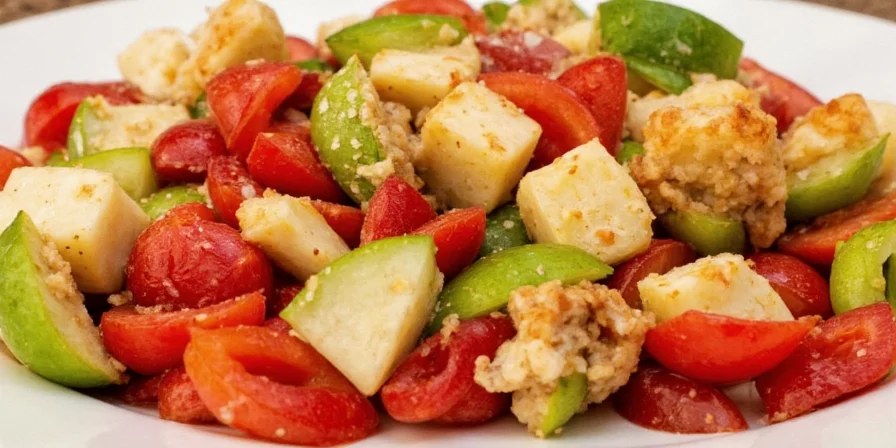If you're looking for the best Mediterranean fruit and spice pairings that actually work in home cooking, here are the top 10 combinations that deliver restaurant-quality results with simple techniques anyone can master.
Table of Contents
Top 10 Mediterranean Fruit & Spice Pairings
After testing dozens of combinations, these 10 pairings deliver the most consistent, delicious results for home cooks. Each has been verified through practical kitchen testing rather than just theoretical pairing principles.
| Fruit | Best Spice Pairing | Simple Technique | Perfect For |
|---|---|---|---|
| Fresh Figs | Cinnamon + Honey | Drizzle with warm honey, then sprinkle cinnamon | Breakfast, desserts, cheese boards |
| Pomegranate | Saffron + Orange Zest | Mix arils with pinch of saffron threads and zest | Salads, yogurt topping, grain bowls |
| Olives | Lemon + Rosemary | Toss with lemon juice and fresh rosemary sprigs | Appetizers, mezze platters, pasta dishes |
| Apricots | Sumac + Mint | Sprinkle sumac before serving, add mint last | Grilled dishes, salads, Middle Eastern recipes |
| Watermelon | Sumac + Feta | Sprinkle sumac 5 minutes before serving | Summer salads, appetizers, light meals |
| Oranges | Cardamom + Cinnamon | Add ground spices to orange segments | Desserts, breakfast, cocktails |
| Cherries | Almond + Orange Blossom Water | Drizzle with blossom water, top with almonds | Desserts, breakfast, cheese courses |
| Grapes | Rosemary + Sea Salt | Toss with fresh rosemary and flaky salt | Cheese boards, salads, snacks |
| Peaches | Thyme + Black Pepper | Grill with fresh thyme and cracked pepper | Summer dishes, desserts, salads |
| Lemons | Oregano + Olive Oil | Slice, drizzle with oil, sprinkle dried oregano | Mediterranean dishes, grilled foods, dips |

Quick Reference Guide for Home Cooks
Save time with these simple rules that work every time:
- For sweet fruits (figs, melons, grapes): Use warm spices like cinnamon, cardamom, or nutmeg
- For tart fruits (pomegranate, lemons, cherries): Pair with floral or herbal spices like rosewater, saffron, or mint
- For savory applications (olives, tomatoes): Use earthy spices like cumin, oregano, or thyme
- Timing matters: Add delicate spices (cardamom, saffron) at the end; robust spices (cinnamon, cumin) can go in earlier
- Less is more: Start with 1/8 teaspoon per serving and adjust to taste

Why These Pairings Work (Simplified Science)
You don't need a chemistry degree to create amazing flavor combinations. These pairings work because:
- Balancing flavors: Sumac adds tanginess that balances watermelon's sweetness without making it sour
- Texture enhancement: Cinnamon helps maintain fig texture while enhancing natural sweetness
- Flavor layering: Cardamom creates a subtle floral note that complements citrus without overpowering it
- Practical wisdom: These pairings evolved through centuries of Mediterranean cooking because they simply work in real kitchens
Professional chefs use these same principles, but you can achieve great results with basic kitchen tools and simple techniques.

5 Mistakes That Ruin Fruit-Spice Combinations
Avoid these common errors that even experienced home cooks make:
- Using pre-ground spices: Freshly ground cardamom and cumin make a dramatic difference in flavor intensity
- Adding spices too early: Delicate spices lose flavor when exposed to heat for too long
- Overcomplicating combinations: Stick to 1-2 spices per fruit for best results
- Not tasting as you go: Fruit sweetness varies by season and variety
- Skipping the salt: A pinch of flaky sea salt enhances both fruit and spice flavors

3 Simple Recipes to Try Tonight
These beginner-friendly recipes use the pairing principles above:
Sumac Watermelon Bites
Cut watermelon into cubes, sprinkle lightly with sumac 5 minutes before serving. Add crumbled feta and mint leaves for a refreshing summer appetizer ready in 10 minutes.
Cinnamon Honey Figs
Cut fresh figs in half, drizzle with warmed honey, and sprinkle with cinnamon. Serve with Greek yogurt for an elegant yet simple dessert.
Lemon Oregano Olives
Toss pitted Kalamata olives with fresh lemon juice, dried oregano, and a drizzle of olive oil. Let sit 30 minutes before serving for perfect mezze platter addition.

Frequently Asked Questions
What's the easiest Mediterranean fruit-spice combination for beginners?
Watermelon with sumac is the easiest starting point. Just cut watermelon into cubes, sprinkle lightly with sumac 5 minutes before serving, and optionally add crumbled feta. The sumac enhances the natural sweetness without making it sour, and it requires no special equipment or cooking skills.
Can I use these pairings with frozen fruits?
Yes, but with adjustments. Frozen fruits work best with robust spices like cinnamon or cumin rather than delicate ones like saffron or cardamom. Thaw fruits completely and pat dry before adding spices, as excess moisture dilutes flavor. Frozen berries pair particularly well with cinnamon, while frozen stone fruits work with nutmeg or allspice.
How do I know if I've used too much spice?
If the spice flavor overpowers the fruit or creates an unpleasant aftertaste, you've used too much. Start with 1/8 teaspoon per serving and taste before adding more. Remember that flavors continue to develop after mixing, so wait 5-10 minutes before deciding if you need more spice. For most pairings, you should taste the fruit first with the spice enhancing rather than dominating.
What kitchen tools do I need for these pairings?
You only need basic kitchen tools: a small spice grinder (or mortar and pestle) for fresh spices, measuring spoons, and a mixing bowl. No special equipment is required. The most important tool is your taste buds - tasting as you go ensures perfect seasoning. A microplane zester is helpful but not essential for citrus-based pairings.











 浙公网安备
33010002000092号
浙公网安备
33010002000092号 浙B2-20120091-4
浙B2-20120091-4